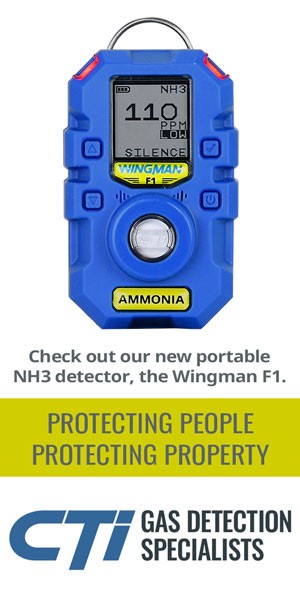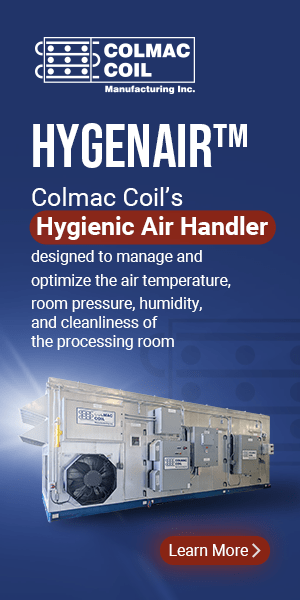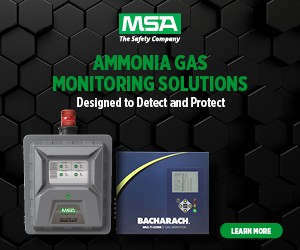Managing Infiltration
“I’ve seen so much ice build-up [in some cases] that it was questionable if the building structure was still safe,” said Bob Port, Director, Technical Services, Supply Chain Engineering for ConAgra Foods. Freezers should be clean and safe to work in, ice caves are freezers that look more like a winter wonder land and this is what happens when we forget that the laws of psychrometrics apply below freezing. “It’s never a good thing when it’s raining or snowing inside a building.”
The development of such an extreme environment can occur when unmanaged moisture infiltrates freezers and is transformed into ice and snow, while the cold air that flows out of freezers, cools improperly conditioned docks, corridors or other building spaces, said Port, who is also a former IIAR Board Chairman.
To avoid the “ice cave effect,” Port suggests taking a multipronged approach, by starting with the source and applying mitigations at each step all the way to the freezer evaporator coils.
For a typical cold storage facility with a refrigerated dock, the truck and dock seals are the starting points.
Next, dock cooling units and the use of re-circulated horizontal air curtains should be examined. Finally make sure that the freezer air mass has some capacity to absorb a reasonable amount of infiltration moisture and carry it all the way back to the evaporator coils.
Dock seals and pit leveler seals don’t cost much to operate, and they reduce overall refrigeration load on both the freezer and refrigerated dock.
Treating infiltration air, both cooling and dehumidifying, on the refrigerated dock is the next, most cost effective, step. Generally, it costs between 1 to 1.5 hp per ton vs 3 to 4 hp per ton.
One way to get maximum cost effective dehumidification is to apply reheat to dock evaporator units.
“We often forget about the exfiltration air that comes out of freezers. Equal amounts of air enter and exit at freezer doorways,” said Port. “When this happens, exfiltration air cools the dock and units designed to cool the dock shut off, temperature is satisfied, infiltration air is no longer treated and the dock is now cooled at 3 to 4 hp per ton. In one extreme case I have even seen a dock floor heaved due to freezer exfiltration. With the advent of automated freezers and storage retrieval systems, dock doors can remain open for hours at a time.”
Installing horizontal recirculated air curtain vestibules at doorways between docks and the freezer can help mitigate this problem, by reducing air exchange up to 80 percent in some cases while stabilizing infiltration and exfiltration psychrometric properties, said Port.
“These curtains capture air flowing from both sources and average out both temperature and humidity. It’s not that you like warmer air getting into the freezer, but it has less humidity and more energy in it, so any moisture entering the freezer will make it to the evaporator coils and be taken out,” he added.
Once the maximum mitigation has been applied to the infiltration issue, Port said facilities must look at how they operate inside the freezer. Specifically, they must understand the impact of operating freezer coils with not enough of a differential between air temperature in the freezer and the operating coil temperature.
“You don’t want to raise suction pressure to where you get less than a 10°F temperature difference. Otherwise, you’ll start to see frost accumulation, even if you’re doing everything right on the dock,” said Port. “Operating costs will also start to rise as a result of this accumulation. It impacts overall refrigeration load by 1114 BTU’s per lb as water turns from vapor to ice to form an ice cave in a freezer.”
“Ice formation starts above the doorway and over time begins growing inside the freezer. It creeps like a glacier,” he added. “All the time you’re operating your freezer that ice cap is growing, and then, when the freezer doesn’t have traffic, your coils are working to cool things down and that ice sublimates. Then the water vapor refreezes farther into the freezer once freezer traffic starts back up. By the time the freezer is really starting to look like a first-rate ice cave, you have paid to re-freeze pounds and pounds of ice and frost multiple times.”
In some instances, taking a radical approach for freezer air mass conditions – by reheating coils on freezer evaporator units – may work.
Port said that approach worked well in one situation with a 0°F freezer located next to an unconditioned corridor, with high relative humidity conditions.
“Some people thought it was the dumbest thing they’d ever heard of,” he said. “I knew infiltration was going to be a problem and the only mitigation would be maintaining a dry freezer air mass.” That freezer has been clean since day one of the re-heat oil modifications.












